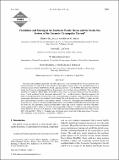Circulation and Stirring in the Southeast Pacific Ocean and the Scotia Sea Sectors of the Antarctic Circumpolar Current
Author(s)
Balwada, Dhruv; Speer, Kevin G.; Owens, W. Brechner; Marshall, John C; Ferrari, Raffaele; LaCasce, Joseph H., 1964-; ... Show more Show less
DownloadCirculation and stirring.pdf (8.007Mb)
PUBLISHER_POLICY
Publisher Policy
Article is made available in accordance with the publisher's policy and may be subject to US copyright law. Please refer to the publisher's site for terms of use.
Terms of use
Metadata
Show full item recordAbstract
The large-scale middepth circulation and eddy diffusivities in the southeast Pacific Ocean and Scotia Sea sectors between 110° and 45°W of the Antarctic Circumpolar Current (ACC) are described based on a subsurface quasi-isobaric RAFOS-float-based Lagrangian dataset. These RAFOS float data were collected during the Diapycnal and Isopycnal Mixing Experiment in the Southern Ocean (DIMES). The mean flow, adjusted to a common 1400-m depth, shows the presence of jets in the time-averaged sense with speeds of 6 cm s⁻¹ in the southeast Pacific Ocean and upward of 13 cm s−¹ in the Scotia Sea. These jets appear to be locked to topography in the Scotia Sea but, aside from negotiating a seamount chain, are mostly free of local topographic constraints in the southeast Pacific Ocean. The eddy kinetic energy (EKE) is higher than the mean kinetic energy everywhere in the sampled domain by about 50%. The magnitude of the EKE increases drastically (by a factor of 2 or more) as the current crosses over the Hero and Shackleton fracture zones into the Scotia Sea. The meridional isopycnal stirring shows lateral and vertical variations with local eddy diffusivities as high as 2800 ± 600 m2 s⁻¹ at 700 m decreasing to 990 ± 200 m² s⁻¹ at 1800 m in the southeast Pacific Ocean. However, the cross-ACC diffusivity in the southeast Pacific Ocean is significantly lower, with values of 690 ± 150 and 1000 ± 200 m² s⁻¹ at shallow and deep levels, respectively, due to the action of jets. The cross-ACC diffusivity in the Scotia Sea is about 1200 ± 500 m² s⁻¹.
Date issued
2016-06Department
Massachusetts Institute of Technology. Department of Earth, Atmospheric, and Planetary SciencesJournal
Journal of Physical Oceanography
Publisher
American Meteorological Society
Citation
Balwada, Dhruv; Speer, Kevin G.; LaCasce, Joseph H.; Owens, W. Brechner; Marshall, John and Ferrari, Raffaele. “ Circulation and Stirring in the Southeast Pacific Ocean and the Scotia Sea Sectors of the Antarctic Circumpolar Current a .” Journal of Physical Oceanography 46, no. 7 (July 2016): 2005–2027. © 2016 American Meteorological Society
Version: Final published version
ISSN
0022-3670
1520-0485